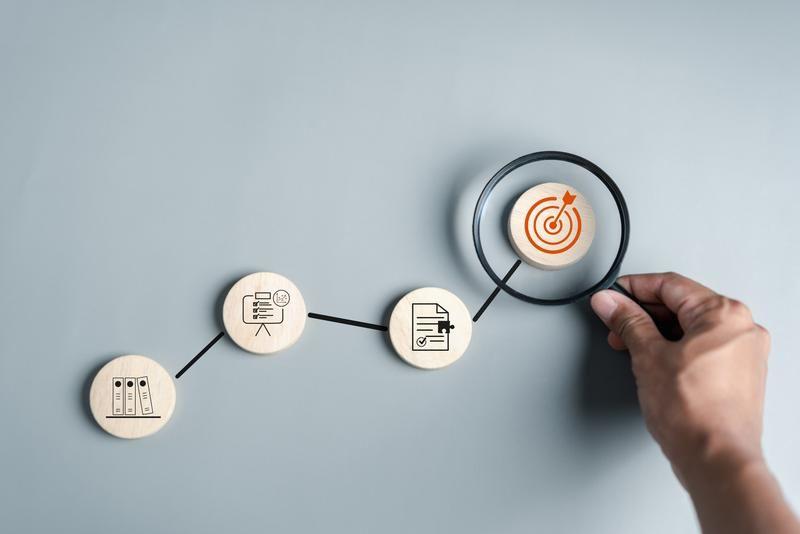A Beginner’s Guide to Data-Driven Marketing

LIKE.TG 成立于2020年,总部位于马来西亚,是首家汇集全球互联网产品,提供一站式软件产品解决方案的综合性品牌。唯一官方网站:www.like.tg
According to Google, nearly 7 in 10 leading marketers say their companies use data to support decision-making at all levels. Data is the driving force behind successful marketing campaigns and can make the difference between merely surviving and thriving in your industry.
Consider all of the amazing data surrounding you—website clicks, customer information, the interactions. All of this data is a goldmine of insights. Now think of this data as a unified map, shaping the way you connect and engage with your audience. Using this data to enhance your campaigns forms the basis of data-driven marketing.
What is Data-driven Marketing?
Data-driven marketing is about leveraging data insights to make informed decisions and optimize marketing strategies. It relies on concrete facts and figures. By tapping into the wealth of information available, you can understand your audience better, predict trends, and tailor the campaigns for maximum impact.
This marketing initiative requires integrating data sources into a centralized repository, where information becomes actionable intelligence. If you’re managing marketing for a healthcare provider, by integrating data from electronic health records, patient surveys, and mobile app usage, you create a comprehensive profile of patient preferences and behaviors. This enables you to send targeted health education materials, appointment reminders, and wellness tips, fostering a more personalized and effective patient communication strategy.
Keep in mind that data-driven marketing isn’t just about collecting data; it’s about turning that data into actionable insights. This approach empowers marketers to make strategic decisions based on timely information, creating a more dynamic and responsive marketing strategy.
Effective Data-Driven Marketing Campaigns Drive Benefits
Data-backed initiatives can have a large positive effective on a company’s revenue.
- TaxJar, a SaaS paltform for managing taxes, analyzed their data to find that they were saving clients huge amounts of money compared to the price they were charging. This insight enabled them to triple their revenue in a year by creating a tier-based pricing model.
- KICKS, a cosmetics provider in Scandanavia, provide a personalized online shopping experience for each customer. This experience is based on past shopping behavior. The result: a 1000% increase in email subscribers.
- GreenPal, a lawncare service provider, saw a 30% increase in conversions after targeting their cost-effective plans to lower-income neighborhoods.
Data-driven Marketing Use Cases
The applications of data-driven marketing are vast and varied. From personalized content recommendations to targeted advertising, the possibilities are limited only by the granularity and quality of the data at your disposal.
Precision in Identifying Prospects with Predictive Lead Scoring
Predictive lead scoring assigns numerical values to leads based on historical data, determining the likelihood of conversion. A software company might analyze past customer data to identify patterns indicative of a high-conversion lead, such as a common location or job title. This technique allows the sales team to prioritize efforts on leads with the highest potential, optimizing resource allocation and improving conversion rates.
Customizing Content through Dynamic Website Personalization
Data-driven marketing enables real-time adaptation of website content based on user behavior. Using tools that analyze user interactions, a travel website can dynamically adjust content to showcase destinations and offers that align with the user’s browsing history and preferences. This level of personalization enhances the user experience and increases the likelihood of conversion.
Improving Campaigns via A/B Testing with Behavioral Analytics
Combining A/B testing with behavioral analytics provides a granular understanding of user responses to different campaign variations. An e-commerce platform might test two versions of a promotional email, analyzing click-through rates and purchase behavior. The insights gained enable marketers to refine their campaigns and optimize for elements that resonate most with their audience.
Understanding Customer Touchpoints through Attribution Modeling
Data-driven marketing allows for sophisticated attribution modeling or considering multiple touchpoints in a customer’s journey. A retailer using advanced analytics can track conversions to both the last interaction and the complete customer journey. This comprehensive understanding of touchpoints informs marketing decisions, helping allocate budgets effectively across channels that contribute most to conversions.
Data-driven Marketing Best Practices
Here are some straightforward strategies that can help optimize your marketing approach for the best results:
- Customer-Centric Approach: Place the customer at the center of your marketing efforts. Understand their needs, preferences, and pain points and tailor your strategies to provide them with value specifically, which in turn builds lasting relationships.
- Cross-Channel Consistency: Maintain a consistent brand message and identity across all marketing channels. Whether it’s social media, email, or traditional advertising, a cohesive brand presence reinforces recognition and trust.
- Agile Marketing Practices: Embrace agility in marketing by adapting quickly to changing trends and consumer behaviors. Stay responsive to market dynamics and allow for timely adjustments to campaigns and strategies.
- Continuous Testing and Optimization: Implement a culture of continuous improvement through testing. Regularly test and optimize various elements of your marketing mix, from ad creatives to messaging, to find what resonates best with your audience.
- Performance Metrics Tracking: Establish and track KPIs to measure the success of your marketing efforts. Regularly analyze metrics like conversion rates, click-through rates, and customer acquisition costs to gauge performance.
- Personalization at Scale: Leverage personalization techniques to connect with your audience on an individual level. Use data to tailor messages and experiences, ensuring that your marketing is relevant and resonant for every customer.
- Customer Feedback Integration: Actively seek and integrate customer feedback into your marketing strategies. This not only demonstrates a commitment to customer satisfaction but also provides valuable insights for refinement and improvement.
Data-driven Marketing Automation
Automation plays a crucial role in data-driven marketing. Once you’ve set your marketing goals and gathered data from different sources, you won’t need to deal with the manual tasks of transforming, validating, and creating a centralized repository. Thanks to automated data pipelines, these processes happen smoothly for you.
Let’s say you’re collecting data from customer interactions or market trends. With automated pipelines, this data transforms and seamlessly flows into your centralized repository. These pipelines also quickly spot and fix any inconsistencies, guaranteeing the accuracy of your data. Building a centralized repository becomes a breeze as automated pipelines bring together information from various sources into a coherent format, saving you time and reducing errors.
Connecting to BI tools for strategic insights becomes a dynamic, near-real-time process. Automated pipelines facilitate this connection, allowing for swift visualization of trends and actionable strategies. Picture a scenario where, with a click, your team can access up-to-the-minute insights on campaign performance or customer behavior.
Automation allows your marketing team to focus on high-value tasks like interpreting transformed data and refining strategies rather than handling repetitive, manual processes. It enhances efficiency and adaptability, enabling swift responses to market shifts. Automated data pipelines move your data-driven marketing strategy forward—serving as a scalable, agile, and precise framework for sustained success.
Final Word
In a world where every user action holds significance, data-driven marketing becomes your catalyst for progress. It’s not just about executing campaigns; it’s about establishing connections, fostering engagement, and continually evolving. Through data utilization, you’re not merely gaining insights into your audience; you’re developing a tailored approach based on precise consumer behavior analytics.
Combining data spread across many sources is the first step in analyzing customer info. ETL tools, like LIKE.TG, help gather data and prepare it for analysis. They also empower users to automate the data collection part, allowing them to focus on what matters – strategizing.
Transform Your Marketing Strategy Today!
LIKE.TG empowers marketers to make informed decisions by automating the data journey. Fuel your success with data-driven strategies that resonate with your audience and deliver measurable results.
Learn More!
现在关注【LIKE.TG出海指南频道】、【LIKE.TG生态链-全球资源互联社区】,即可免费领取【WhatsApp、LINE、Telegram、Twitter、ZALO云控】等获客工具试用、【住宅IP、号段筛选】等免费资源,机会难得,快来解锁更多资源,助力您的业务飞速成长!点击【联系客服】
本文由LIKE.TG编辑部转载自互联网并编辑,如有侵权影响,请联系官方客服,将为您妥善处理。
This article is republished from public internet and edited by the LIKE.TG editorial department. If there is any infringement, please contact our official customer service for proper handling.


















